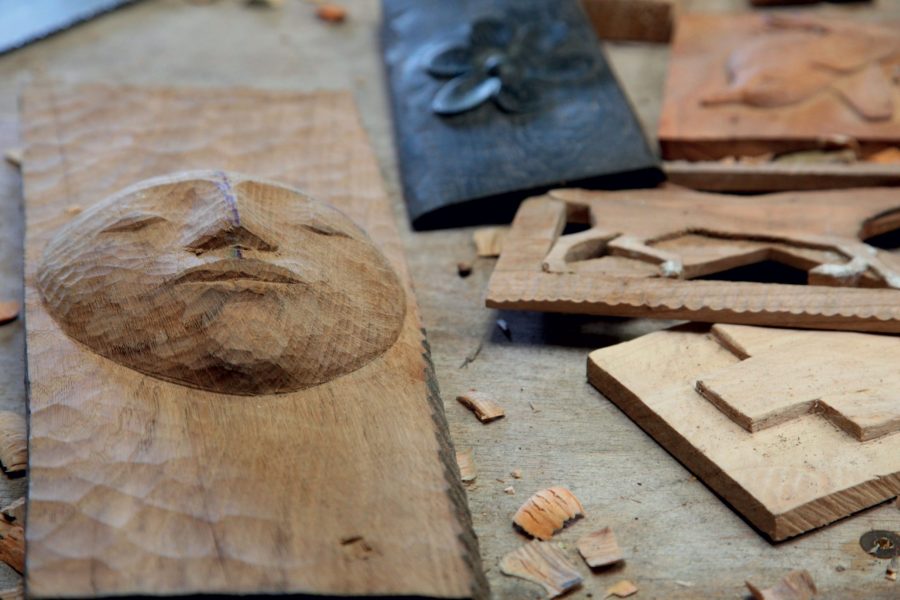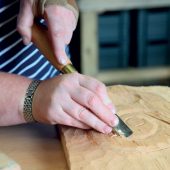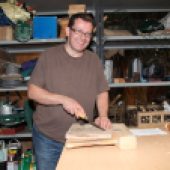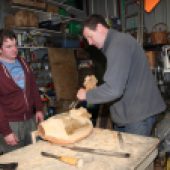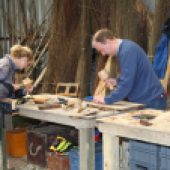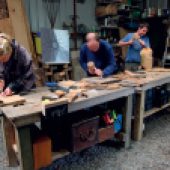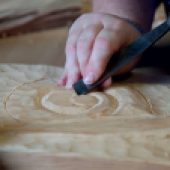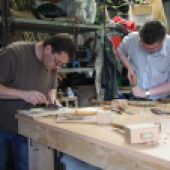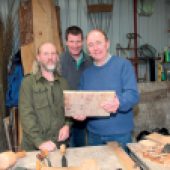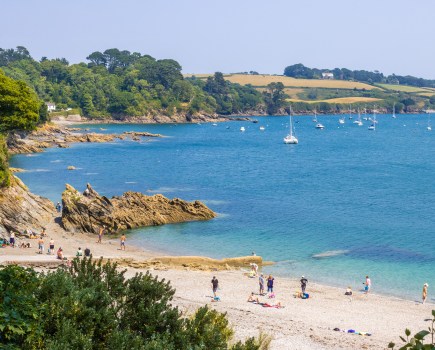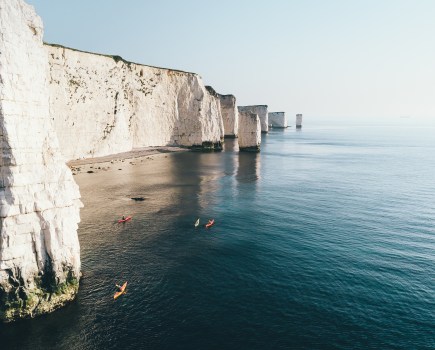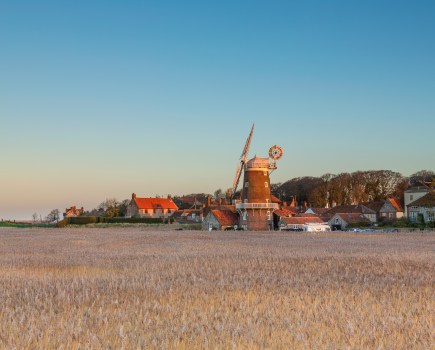Paul Symington heads to Strangford Lough near the seaside village of Portaferry to try his hand at the traditional technique of woodcarving
STRANGFORD Lough in Northern Ireland is one of only three designated marine nature reserves in the UK, a unique and wonderful place of immense international importance for nature conservation. Onshore, the many craft producers who live around this beautiful lough are rapidly gaining their own reputation, not just for their outstanding creations, but for the way they are keenly passing on their skills to a host of ‘students’ keen to learn what was once commonly practised.
Welig Heritage Crafts is a family-operated craft business to the North East of the seaside village of Portaferry. The business is run by Clive Lyttle and Elaine Burke, who produce traditional and contemporary basketry, willow sculptures, coppice products and public art.
The couple have expanded their repertoire to hands-on workshops, giving people the opportunity to learn a craft during a day at Welig’s own studio and atelier. Clive and Elaine take some of the workshops themselves, but they also bring in specialist tutors, thus expanding the breadth of skills that can be experienced.
Paul Symington took a woodcarving workshop at Welig with renowned workcarver Owen Crawford, from the nearby village of Carrowdore. Largely self-taught, Owen has been carving for more than 25 years. His work can be found in many public spaces across Northern Ireland and his exhibitions are keenly awaited and much visited.
9.30am SELECTION PROCESS
Owen’s six ‘students’ arrive at Welig and settle in to the workshop – a spacious barn with two large, expansive benches. We are invited to select the type of wood we will be carving – green oak, a rich brown wood, which would take up to a year to dry; full dried oak, a hard wood that has a much lighter colour; and cypress, a fudge-coloured conifer. I chose the green oak and selected a piece of wood about 18 x 12 inches and an inch in depth. Then came the bombshell.
‘Right, what are you going to carve?’ asked Owen. In my naivety, I had expected to be led by the hand through the session, being told what to carve and closely directed towards a predetermined outcome. Not so – we would
be carving our own designs.
10.30am FINDING INSPIRATION
Owen presented us with pencils, and told us to sketch out our design on the wood. As other members of the group got to work – one even had a pre-drawn design on paper – I agonised, pencil poised but mind blank. Suddenly I had a brainwave.
Every morning I walk on the stunning Murlough Beach, a Blue Flag strand that sits against the backdrop of the Mourne Mountains. I decided to carve that glorious landscape and I even had a photo on my phone to copy.
11am GETTING TO GRIPS WITH THE TOOLS
The carving got underway under Owen’s expert tutelage. He glided between us all in turn, showing us the techniques we would need, introducing us to the tools and continually sharpening chisels, which were quickly blunted by our inexperienced hacking. We each had a wooden mallet and a variety of different-sized chisels‚ bigger ones for dramatic effects and smaller ones for more subtle impacts.
At my bench were Joan and Chris. Joan had considerable artistic talent and sketched a beautiful drooping branch with hanging leaves, which reminded me of a Japanese silk screen panel. Chris, a joiner, eschewed the wood panels chosen by everyone else and selected a large log, announcing he was going to carve a three-dimensional duck. For someone of my extremely limited technical ability, I just couldn’t conceive how he would do it, but Owen seemed pleased by such ambition and helped him on his way.
I started out with a small chisel, etching out the outline of the mountains, followed by the forest on the lower slopes and finally the beach and sea. The workshop was quiet, save for the tapping of mallets and Owen’s advice, as everyone concentrated on this crucial stage of their projects.
12pm designs emerging
Gradually the designs grew out of the wood. On the two benches there was my mountain/beach landscape, a tiger, a snail, a chemical symbol and Joan’s wonderful floral display. All seemed to be progressing, except for Chris’ duck. He attacked his lump of wood with a saw, hatchet and the biggest chisel he could find, but none of us could see the duck shape he was striving for. Undaunted, Chris battered away, mallet hammering and chisel gouging towards a shape he was confident of achieving.
Once my outline was finally etched out, Owen showed me how important texture is in woodcarving. Using various chisels and different techniques it was possible to differentiate between my mountains and forest, sea and beach, and after a while I began to believe that perhaps I was capable of producing a credible woodcarving.
2pm Taking SHAPE
After a gorgeous homemade lunch we continued to work on our carvings, with Owen encouraging us to begin putting the final details into our work – the smaller aspects of the design that would encapsulate fully the shape or picture we were trying to create.
Gradually, everyone noticed that Chris’ hard labour was finally starting to pay off. There was a discernible duck shape emerging from his lump of wood, and the justified praise heaped upon him seemed to spur him on in a new frenzy of carving.
4pm finishing touches
With the exception of Chris, who was now wielding a huge file and trying to shape the duck, we put the finishing touches to our carving, and Owen helped us with the final presentation.
The wood blocks had rough edges and needed trimming, so he encouraged us to think about how we should present the carving – as a wall hanging or a stand-alone ornament. Joan wanted her Japanese panel to weather in the garden, but I thought my landscape would look best on a wall. Owen showed me how to carve the edges of the block and create a frame for the landscape, which surprisingly lifted it out of the wood and better defined the carving.
After hours of sketching, etching and carving I left with my landscape under my arm and a spring in my step. Am I now a woodcarver? Definitely not, but would I try it again? Absolutely. Even though I was surrounded by others, there was a delightful isolation in creating something so personal, in using tools and techniques I had long abandoned any hope of commanding, and in supporting the wonderful craft producers who are doing so much to preserve and hand down these ancient skills.
Need to know
HOW TO GET STARTED
To find out more information about woodcarving and all the Hands On Workshops at Welig Heritage Crafts, contact Clive Lyttle on 07732 600907 or check online at weligcrafts.co.uk. For details of courses across the British Isles, visit britishwoodcarversassociation.co.uk.
HOW TO GET THERE
From Belfast it’s about a 45-minute drive south along the Ards peninsula towards Portaferry. Take the signposts for Cloughey and watch out for the signs for Welig Heritage Crafts. If you’re coming from the west of the Province then don’t miss out on a trip on the beautiful Strangford Lough ferry service. Once you disembark it’s just a 10-minute drive to Welig.
WHERE TO STAY
The Portaferry Hotel (portaferryhotel.com) is just 10 minutes away and sits right on the promenade with views out across Strangford Lough. Alternatively, there are many excellent self-catering cottages and B&Bs in the area.
WHAT IT COSTS
A day-long workshop at Welig Heritage Crafts (9am-5pm) costs £65, which includes a homemade lunch and all the tea and coffee you can drink.
ASK THE PRO
Owen Crawford was a joiner when a client asked if he knew anyone who could carve a staircase post. Owen decided to give it a go and, 25 years later, he has established himself as one of Northern Ireland’s foremost woodcarvers, with many of his creations on view as public art in prominent locations.
‘You have to be able to visualise what you are going to carve. Once you have an image in your mind you can forge ahead with your carving. As your piece progresses, so your visualisation becomes more defined and detailed, until finally you arrive at something as close to your image as you can get.
‘The more you get into carving, the more ambitious you will become, so it is good to research some of the techniques that have been used down through the ages. The carving produced by Polynesian islanders many years ago is amazing, and then there is the intricacy and delicate nature of Japanese carving. All of these different styles are likely to influence the type of wood carver you will become.’

